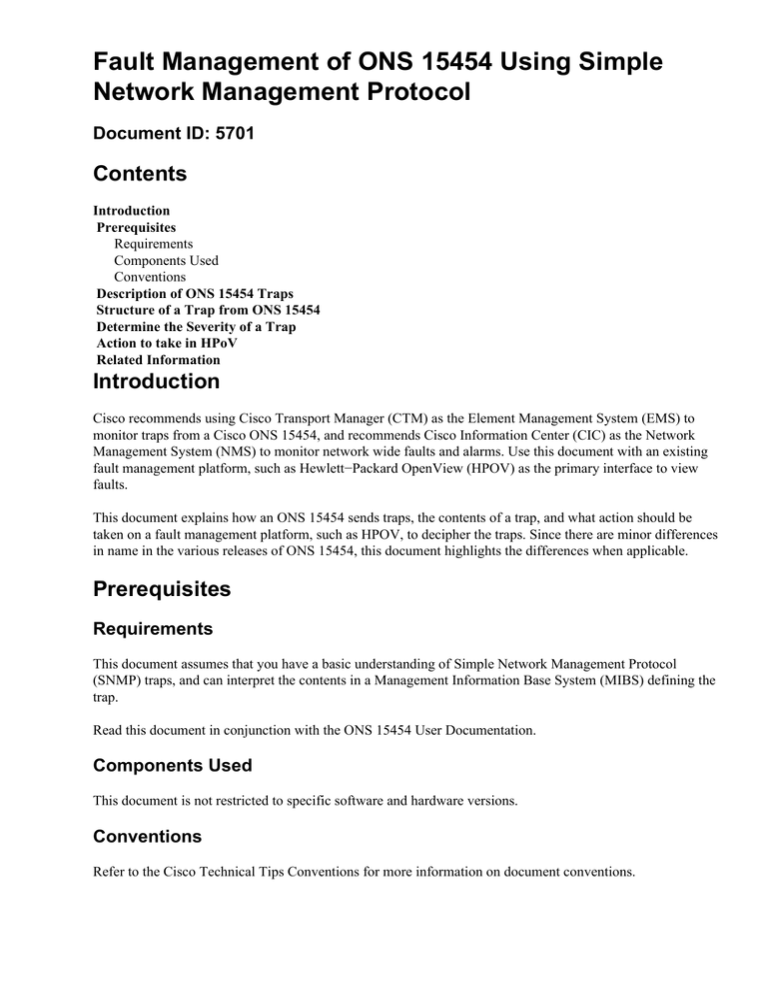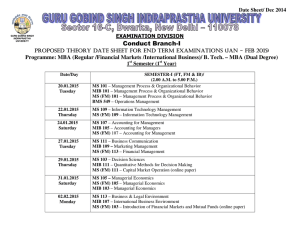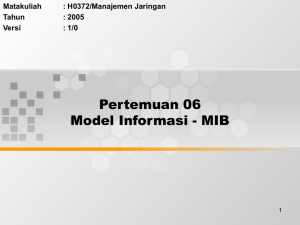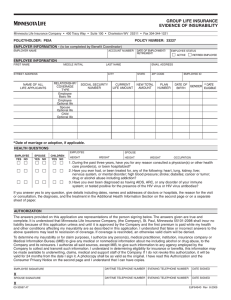
Fault Management of ONS 15454 Using Simple
Network Management Protocol
Document ID: 5701
Contents
Introduction
Prerequisites
Requirements
Components Used
Conventions
Description of ONS 15454 Traps
Structure of a Trap from ONS 15454
Determine the Severity of a Trap
Action to take in HPoV
Related Information
Introduction
Cisco recommends using Cisco Transport Manager (CTM) as the Element Management System (EMS) to
monitor traps from a Cisco ONS 15454, and recommends Cisco Information Center (CIC) as the Network
Management System (NMS) to monitor network wide faults and alarms. Use this document with an existing
fault management platform, such as Hewlett−Packard OpenView (HPOV) as the primary interface to view
faults.
This document explains how an ONS 15454 sends traps, the contents of a trap, and what action should be
taken on a fault management platform, such as HPOV, to decipher the traps. Since there are minor differences
in name in the various releases of ONS 15454, this document highlights the differences when applicable.
Prerequisites
Requirements
This document assumes that you have a basic understanding of Simple Network Management Protocol
(SNMP) traps, and can interpret the contents in a Management Information Base System (MIBS) defining the
trap.
Read this document in conjunction with the ONS 15454 User Documentation.
Components Used
This document is not restricted to specific software and hardware versions.
Conventions
Refer to the Cisco Technical Tips Conventions for more information on document conventions.
Description of ONS 15454 Traps
The ONS 15454 uses SNMP traps as one mechanism to inform its upper level management systems of any
alarm condition experienced during its operation. The MIBS for ONS 15454 Software Release 2.2 is defined
in these three files:
• cerentRegistry.mib
• cerentTC.mib
• cerent454.mib
The names of these files have been changed since Release 4.6 of the ONS 15454 system software to indicate
the name of the MIBS modules. The names of these MIBS files are:
• CERENT−GLOBAL−REGISTRY.mib
• CERENT−TC.mib
• CERENT−454−MIB.mib
• CERENT−GENERIC−MIB.mib (for ONS 15327 only)
• CISCO−SMI.mib
• CISCO−VOA−MIB.mib
• CERENT−MSDWDM−MIB.mib
• CISCO−OPTICAL−MONITOR−MIB.mib
• CERENT−FC−MIB.mib
Note: The CERENT−MSDWDM−MIB.mib and CERENT−FC−MIB.mib in the CiscoV2 directory support
64−bit performance monitoring counters. However, the respective SNMPv1 MIB in the CiscoV1 directory
does not contain 64−bit performance monitoring counters, but supports the lower and higher word values of
the corresponding 64−bit counter. The other MIB files in the CiscoV1 and CiscoV2 directories are identical in
content and differ only in format.
Note: Different MIB files are used for the ONS 15454 (or ONS 15454 SDH) and the ONS 15327,
respectively. The file CERENT−454−MIB.mib contains the object and trap definitions pertaining to the ONS
15454 (both SONET and SDH platforms). The file CERENT−GENERIC−MIB.mib contains the object and
trap definitions pertaining to the ONS 15327. When provisioning the Network Management System for the
ONS 15454 or ONS 15454 SDH, use the file CERENT−454−MIB.mib. When provisioning the Network
Management System for the ONS 15327, use the file CERENT−GENERIC−MIB.mib.
A unique feature of SNMP is that a particular version of a MIBS is always compatible with all the earlier
versions of the same file. For instance, the CERENT−454−MIB.mib file from the Release 3.0 distribution CD
is compatible with software version Release 2.2.3, 2.2.1, 2.0, and so on. This is a mandatory property of every
SNMP MIBS, and Cisco Optical Transport Business Unit (OTBU) proprietary MIBS files are no exception.
Structure of a Trap from ONS 15454
The traps of the ONS 15454 are defined in the cerent454.mib file. This is the CERENT−454−MIB.mib file in
release 3.0. Traps generated by the ONS 15454 contain an object ID that uniquely identifies the alarm. An
entity identifier uniquely identifies which entity generated the alarm (slot, port, Synchronous Transport Signal
[STS], Virtual Tributary [VT], Bidirectional Line Switched Rings [BLSR], Spanning−Tree Protocol [STP],
and so on). The traps give the severity of the alarm (critical, major, minor, event, and so on), and indicate
whether the alarm is service affecting or non−service affecting. The traps also contain a date/time stamp that
shows the date and time the alarm occurred. The ONS 15454 also generates a trap for each alarm when the
alarm condition clears. Each SNMP trap contains ten variable bindings.
This table shows the structure of an ONS 15454 trap:
SNMP
Trap
Variable
Bindings
for ONS
15454
Number
1
2
3
4
5
6
7
Name
sysUpTime
Description
The first variable
binding in the variable
binding list of a
SNMPv2−Trap−PDU.
snmpTrapOID
The second variable
binding in the variable
binding list of a
SNMPv2−Trap−PDU.
cerentNodeTime
This variable gives the
time that an event
occurred.
cerent454AlarmState
This variable specifies
alarm severity and
service−affecting
status. Severities are
minor, major and
critical. Service−
affecting statuses are
service−affecting and
non−service affecting.
cerent454AlarmObjectType
This variable provides
the entity type that
raised the alarm. The
NMS should use this
value to decide which
table to poll for further
information about the
alarm.
cerent454AlarmObjectIndex
Every alarm is raised
by an object entry in a
specific table. This
variable is the index of
the objects in each
table. If the alarm is
interface related, this
is the index of the
interfaces in the
interface table.
cerent454AlarmSlotNumber
This variable indicates
the slot of the object
that raised the alarm. If
a slot is not relevant to
the alarm, the slot
number is zero.
8
9
10
cerent454AlarmPortNumber
This variable provides
the object line that
raised the alarm. If a
cerent454AlarmLineNumber
line is not relevant to
the alarm, the line
number is zero.
This variable gives the
TL1−style user−visible
cerent454AlarmObjectName name which uniquely
identifies an object in
the system.
SNMP
Trap
Variable
Bindings
used in
ONS
15327
Number
1
2
This variable provides
the port of the object
that raised the alarm. If
a port is not relevant to
the alarm, the port
number is zero.
Name
sysUpTime
snmpTrapID
Description
This table holds
all the currently
raised alarms.
When an alarm is
raised, it appears
as a new entry in
the table. When
an alarm is
cleared, it is
removed from the
table and all the
subsequent
entries move up
by one row.
This variable
uniquely
identifies each
entry in an alarm
table. When an
alarm in the
alarm table
clears, the alarm
indexes change
for each alarm
located
subsequent to the
cleared alarm.
3
4
5
6
7
cerentNodeTime
This variable
gives the time
that an event
occurred.
cerentGenericAlarmState
This variable
specifies alarm
severity and
service−affecting
status. Severities
are minor, major
and critical.
Service−
affecting statuses
are
service−affecting
and non−service
affecting.
cerentGenericAlarmObjectType
This variable
provides the
entity type that
raised the alarm.
The NMS should
use this value to
decide which
table to poll for
further
information about
the alarm.
cerentGenericAlarmObjectIndex
Every alarm is
raised by an
object entry in a
specific table.
This variable is
the index of the
objects in each
table; if the alarm
is interface
related, this is the
index of the
interfaces in the
interface table.
cerentGenericAlarmSlotNumber
This variable
indicates the slot
of the object that
raised the alarm.
If a slot is not
relevant to the
alarm, the slot
number is zero.
8
9
10
cerentGenericAlarmPortNumber
This variable
provides the port
of the object that
raised the alarm.
If a port is not
relevant to the
alarm, the port
number is zero.
This variable
provides the
object line that
raised the alarm.
cerentGenericAlarmLineNumber
If a line is not
relevant to the
alarm, the line
number is zero.
This variable
gives the
TL1−style
user−visible
cerentGenericAlarmObjectName name which
uniquely
identifies an
object in the
system.
The IETF standard documents, known as requests for comments (RFCs), contain MIB object definitions with
detailed descriptions. These definitions are extracted from the RFCs and made available as MIB files on the
CD. RFCs can be obtained from many sources such as the official IETF website .
These standard MIB files, included on the CD, must be loaded into your network management system. They
are located in the Standard directory.
IETF
Standard
MIBs
Implemented
in the ONS
15454 and
ONS 15327
SNMP Agent
RFC#
Module Name
IANAifType−MIB.mib
1213 1907
RFC1213−MIB−rfc1213.mib,
SNMPV2−MIB−rfc1907.mib
Title/Comments
Internet Assigned
Numbers
Authority
(IANA) ifType
Management
Information Base
for Network
Management of
TCP/IP−based
internets:MIB−II
Management
Information Base
for Version 2 of
the Simple
Network
Management
Protocol
(SNMPv2)
1253
1493
1757
2737
2233
2358
2493
2495
RFC1253−MIB−rfc1253.mib
OSPF Version 2
Management
Information Base
BRIDGE−MIB−rfc1493.mib
Definitions of
Managed Objects
for Bridges. This
defines MIB
objects for
managing MAC
bridges based on
the IEEE
802.1D−1990
standard between
Local Area
Network (LAN)
segments.
RMON−MIB−rfc1757.mib
Remote Network
Monitoring
Management
Information Base
ENTITY−MIB−rfc2737.mib
Entity MIB
(Version 2)
IF−MIB−rfc2233.mib
The Interfaces
Group MIB using
SMIv2
EtherLike−MIB−rfc2358.mib
Definitions of
Managed Objects
for the
Ethernet−like
Interface Types
Textual
Conventions for
MIB Modules
Using
PerfHist−TC−MIB−rfc2493.mib
Performance
History Based on
15 Minute
Intervals
DS1−MIB−rfc2495.mib
Definitions of
Managed Objects
for the DS1, E1,
DS2 and E2
Interface Types
2496
2558
2674
DS3−MIB−rfc2496.mib
Definitions of
Managed Object
for the DS3/E3
Interface Type
SONET−MIB−rfc2558.mib
Definitions of
Managed Objects
for the
SONET/SDH
Interface Type
Definitions of
Managed Objects
for Bridges with
P−BRIDGE−MIB−rfc2674.mib Traffic Classes,
Q−BRIDGE− MIB−rfc2674.mib Multicast
Filtering and
Virtual LAN
Extensions
The ONS 15454 supports generic and Internet Engineering Task Force (IETF) traps. The Standard category
consists of all the IETF and IANA standard MIB files you need for your operations.
This table lists the traps supported in the ONS 15454:
Traps Supported in
the ONS 15454 Trap
coldStart
warmStart
authenticationFailure
newRoot
From RFC#
Description
MIB
RFC1907−MIB Agent up, cold start
RFC1907−MIB Agent up, warm start
Community string does not
RFC1907−MIB
match
RFC1493/
BRIDGE−MIB
Sending agent is the new
root of the spanning tree
topologyChange
RFC1493/
BRIDGE−MIB
A port in a bridge has
changed from Learning to
Forwarding or Forwarding
to Blocking
entConfigChange
RFC2737/
ENTITY−MIB
The entLastChangeTime
value has changed
dsx1LineStatusChange RFC2495/
DS1−MIB
A dsx1LineStatusChange
trap is sent when the value
of an instance
dsx1LineStatus changes.
The trap can be used by an
NMS to trigger polls. When
the line status change
results from a higher−level
line status change (such as
DS−3), no traps for the
DS−1 are sent.
dsx3LineStatusChange RFC2496/
DS3−MIB
risingAlarm
fallingAlarm
A
dsx3LineStatusLastChange
trap is sent when the value
of an instance of
dsx3LineStatus changes.
This trap can be used by an
NMS to trigger polls. When
the line status change
results in a lower−level line
status change (such as
DS−1), no traps for the
lower−level are sent.
RFC1757/
RMON−MIB
The SNMP trap that is
generated when an alarm
entry crosses the rising
threshold and the entry
generates an event that is
configured for sending
SNMP traps.
RFC1757/
RMON−MIB
The SNMP trap that is
generated when an alarm
entry crosses the falling
threshold and the entry
generates an event that is
configured for sending
SNMP traps.
Determine the Severity of a Trap
The type of trap received cannot alone determine the severity of a trap. You must view the inside contents of
the trap to determine the severity of the trap. The alarm/trap severities can be provisioned in the ONS 15454.
The Object Identifier (OID) cerent454AlarmState specifies the severity of the alarm and the service affecting
status. The possible values for cerent454AlarmState are other (1), crucial (10), administrative (20), diagnostic
(30), cleared (40), minorNonServiceAffecting (50), majorNonServiceAffecting (60),
criticalNonServiceAffecting (70), minorServiceAffecting (80), majorServiceAffecting (90),
criticalServiceAffecting (100). The current implementations for Release 2.2 and Release 3.0 do not have any
traps that are of type crucial and diagnostic.
Action to take in HPoV
These steps are written for HP Network Node Manager (NNM) Version 6.1. Consult the user documentation
of your version of HP NNM for more information on how to compile an MIB and on changing contents in the
trapd.conf file. Use this procedure as a guideline:
1. Compile cerentRegistry.mib, cerentTC.mib, and cerent454.mib in the same order as mentioned here
into HPoV.
2. Copy the current trapd.conf as trapd.conf.old. This is an important step. In the event that something
missed, you can always revert the file name and return the original setup.
3. In trapd.conf file, replace the string NO FORMAT DEFINED with $N $2 Object:$3 Index:$4 Slot:$5
Port:$6, using any text editor (VI, Emacs, Wordpad, and so on). Ensure this replacement is done only
for traps loaded from Cisco OTBU proprietary MIBS files.
4. In trapd.conf file, replace the string LOGONLY with Error Alarms, using any text editor (VI, Emacs,
Wordpad, and so on). Ensure this replacement is done only for traps loaded from Cisco OTBU
proprietary MIBS files.
5. This makes every trap received from the 15454 appear appropriately on the alarm browser.
6. Save and restart HPoV.
Related Information
• Optical Technology Support Page
• Technical Support & Documentation − Cisco Systems
Contacts & Feedback | Help | Site Map
© 2014 − 2015 Cisco Systems, Inc. All rights reserved. Terms & Conditions | Privacy Statement | Cookie Policy | Trademarks of
Cisco Systems, Inc.
Updated: May 19, 2006
Document ID: 5701





